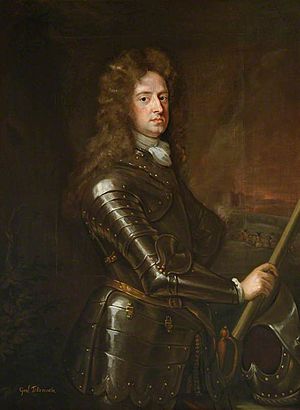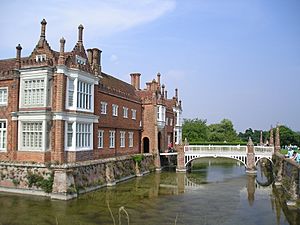Thomas Tollemache facts for kids
Quick facts for kids
Thomas Tollemache
|
|
|---|---|
 |
|
| Member of Parliament for Chippenham |
|
| In office January 1692 – June 1694 |
|
| Governor of Portsmouth | |
| In office 1690–1694 |
|
| Member of Parliament for Malmesbury |
|
| In office January 1689 – February 1690 |
|
| Personal details | |
| Born | 1651 Helmingham Hall, Suffolk |
| Died | 12 June 1694 Plymouth |
| Resting place | St Mary's, Helmingham |
| Nationality | English |
| Alma mater | Queens' College, Cambridge |
| Occupation | Military officer, politician |
| Military service | |
| Allegiance | |
| Branch/service | |
| Rank | Lieutenant-General |
| Unit | Coldstream Regiment of Foot Guards |
| Battles/wars | |
Lieutenant-General Thomas Tollemache (c. 1651 – 12 June 1694) was an English Army officer and politician. He was a brave soldier who fought in many important battles for England. He also served as a Member of Parliament, helping to make laws for the country. Tollemache is remembered for his courage and his loyalty to King William III.
Contents
Early Life and Education
Thomas Tollemache was born in 1651. He was the second son of Sir Lionel Tollemache and Elizabeth, Countess of Dysart. His family lived at Helmingham Hall in Suffolk, England. Thomas never married.
Before starting his military career, Thomas traveled around Europe. When he returned to England in 1668, he studied at Queens' College, Cambridge. He also received legal training at the Inner Temple.
Joining the Army
Thomas Tollemache began his army career around 1673. He served in Germany during the Franco-Dutch War. In 1678, he became a captain in the Coldstream Guards. This was a very famous army unit. He served with them in a place called the Tangier Garrison.
In 1685, he became a lieutenant-colonel in a new army unit called the Royal Fusiliers. However, he resigned in 1686. This was because he disagreed with King James II. The King was allowing Catholic officers into the army, which Thomas did not support.
Thomas then joined a group called the "Treason Club." This group supported William of Orange. William was a Protestant leader from the Netherlands. He was married to James II's daughter, Mary II of England.
In early 1688, Thomas joined a special army unit called the Anglo-Scots Brigade. This unit was part of the Dutch army. He traveled with William of Orange to England in November 1688. This event is known as the Glorious Revolution.
A Leader in the Army
After the Glorious Revolution, Thomas Tollemache became very important.
- He was made the colonel of the Coldstream Guards.
- He also became the Governor of Portsmouth in 1690. This meant he was in charge of the important port city.
- In 1689, he was elected as a MP for Malmesbury.
- Later, in 1692, he was also elected as an MP for Chippenham.
Fighting for England
Thomas Tollemache fought in many battles during the Nine Years' War. This was a big war that involved many European countries.
- His regiment went to Flanders (modern-day Belgium) in 1689. They fought in the Battle of Walcourt.
- In 1691, he served in Ireland. He was a major general there.
- He fought in the Battle of Aughrim.
- He also took part in the sieges of Athlone and Limerick. A siege is when an army surrounds a city to try and capture it.
- After the war in Ireland ended, he returned to Flanders. He fought in the battles of Steenkirk and Landen.
His Final Battle
In 1694, Thomas Tollemache led an attack on the French port of Brest. However, the French army knew the attack was coming. They had made their defenses very strong.
The battle, known as the Battle of Camaret, was a disaster for the English. They lost many soldiers. Thomas Tollemache was badly wounded during this battle. He died from his injuries in Plymouth on June 12, 1694. He was buried in the church of St Mary's at Helmingham, his family home.


